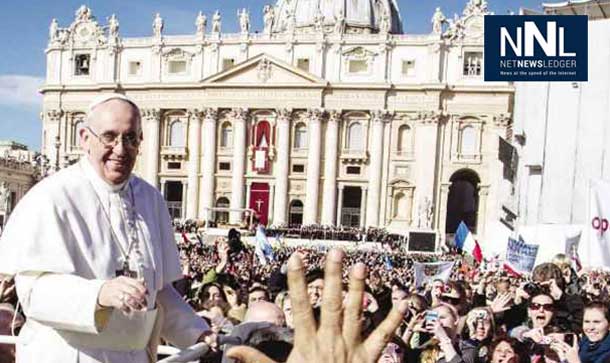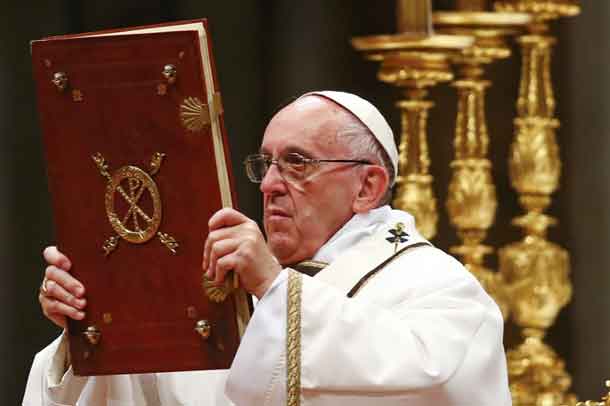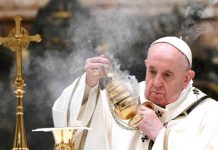Pope Francis marries couples who have cohabited, had children
VATICAN – Pope Francis celebrated the marriage of twenty couples from Rome, the diocese of which he is bishop, during a Holy Mass celebrated in St. Peter’s Basilica. The cardinal vicar of Rome, Agostino Vallini, and Archbishop Filippo Iannone, vice-regent and director of the diocesan Centre for Family Pastoral, concelebrated with the Pontiff.
In St. Peter’s Basilica, Pope Francis is marrying 20 couples — even some who had already lived together and had children.
It’s the Church’s latest push to be more open and inclusive.
His words of advise to these newlyweds were enough to make brides tearful. Pope Francis said, “A small piece of advice: it is normal that newlyweds argue, it happens and it’s normal. But I advise you never to end the day without making peace, never. All it takes is a small gesture. And that is how you’ll keep going forward.”
His approach to the wedding contrasts with that of his predecessor, Pope Benedict, who held the traditional family as sacrosanct.
Bishops from around the world will convene in the Vatican in October for a meeting on the family, and are expected to discuss marriage, divorce and contraception.
The couples married by the Pope, according to a press release from the Vicariate of Rome, are like many others, engaged for different lengths of time; some already live together, others have children, and others met within the parish. The youngest couple were born in 1986 and 1989 respectively, whereas the eldest were born in 1958 and 1965.
In his homily, the Holy Father, commenting on the Bible passage that speaks of the long and wearisome journey of the people of Israel through the desert, spoke of marriage as a path with areas of light and shadows, during which the mercy and grace of Christ can regenerate and channel married and family life.
“Today’s first reading speaks to us of the people’s journey through the desert”, he began. “We can imagine them as they walked, led by Moses; they were families: fathers, mothers, sons and daughters, grandparents, men and women of all ages, accompanied by many children and the elderly who struggled to make the journey. This people reminds us of the Church as she makes her way across the desert of the contemporary world, reminds us of the People of God composed, for the most part, of families.
“This makes us think of families, our families, walking along the paths of life with all their day to day experiences. It is impossible to quantify the strength and depth of humanity contained in a family: mutual help, educational support, relationships developing as family members mature, the sharing of joys and difficulties. Families are the first place in which we are formed as persons and, at the same time, the ‘bricks’ for the building up of society.
“Let us return to the biblical story. At a certain point, ‘the people became impatient on the way’. They are tired, water supplies are low and all they have for food is manna, which, although plentiful and sent by God, seems far too meagre in a time of crisis. And so they complain and protest against God and against Moses: ‘Why did you make us leave?’. They are tempted to turn back and abandon the journey.
“Here our thoughts turn to married couples who ‘become impatient on the way’, the way of conjugal and family life. The hardship of the journey causes them to experience interior weariness; they lose the flavour of matrimony and they cease to draw water from the well of the Sacrament. Daily life becomes burdensome, and often, even ‘nauseating’. During such moments of disorientation – the Bible says – poisonous serpents come and bite the people, and many die. This causes the people to repent and to turn to Moses for forgiveness, asking him to beseech the Lord so that he will cast out the snakes. Moses prays to the Lord, and the Lord offers a remedy: a bronze serpent set on a pole; whoever looks at it will be saved from the deadly poison of the vipers.
“What is the meaning of this symbol? God does not destroy the serpents, but rather offers an ‘antidote’: by means of the bronze serpent fashioned by Moses, God transmits his healing strength, namely his mercy, which is more potent than the Tempter’s poison.
“As we have heard in the Gospel, Jesus identifies Himself with this symbol: out of love the Father ‘has given’ His only begotten Son so that men and women might have eternal life. Such immense love of the Father spurs the Son to become man, to become a servant and to die for us upon a cross. Out of such love, the Father raises up his Son, giving Him dominion over the entire universe. This is expressed by Saint Paul in his hymn in the Letter to the Philippians. Whoever entrusts himself to Jesus crucified receives the mercy of God and finds healing from the deadly poison of sin.
“The cure which God offers the people applies also, in a particular way, to spouses who ‘have become impatient on the way’ and who succumb to the dangerous temptation of discouragement, infidelity, weakness, abandonment. To them too, God the Father gives His Son Jesus, not to condemn them, but to save them: if they entrust themselves to Him, He will bring them healing by the merciful love which pours forth from the Cross, with the strength of His grace that renews and sets married couples and families once again on the right path.
“The love of Christ, which has blessed and sanctified the union of husband and wife, is able to sustain their love and to renew it when, humanly speaking, it becomes lost, wounded or worn out. The love of Christ can restore to spouses the joy of journeying together. This is what marriage is all about: man and woman walking together, wherein the husband helps his wife to become ever more a woman, and wherein the woman has the task of helping her husband to become ever more a man. This is the task that you both share. ‘I love you, and for this love I help you to become ever more a woman’; ‘I love you, and for this love I help you to become ever more a man’. Here we see the reciprocity of differences. The path is not always a smooth one, free of disagreements, otherwise it would not be human. It is a demanding journey, at times difficult, and at times turbulent, but such is life! Within this theology which the word of God offers us concerning the people on a journey, spouses on a journey, I would like to give you some advice. It is normal for husband and wife to argue: it’s normal. It always happens. But my advice is this: never let the day end without having first made peace. Never! A small gesture is sufficient. Thus the journey may continue. Marriage is a symbol of life, real life: it is not ‘fiction’! It is the Sacrament of the love of Christ and the Church, a love which finds its proof and guarantee in the Cross. My desire for you is that you have a good journey, a fruitful one, growing in love. I wish you happiness. There will be crosses! But the Lord is always there to help us move forward. May the Lord bless you!”.
by Reuters












